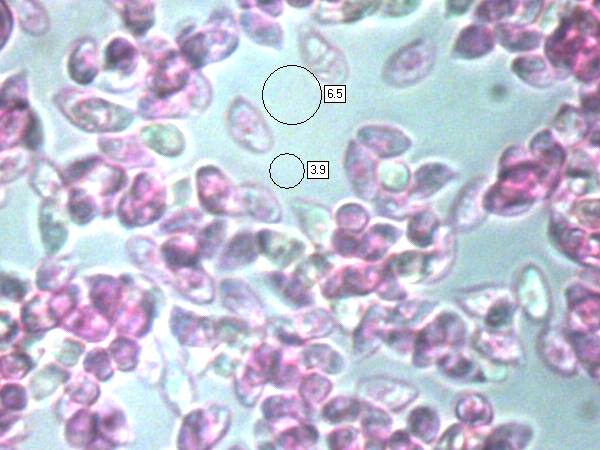Marasmius wynneae (= Marasmius wynnei) Berk. & Broome - Pearly Parachute
Phylum: Basidiomycota - Class: Agaricomycetes - Order: Agaricales - Family: Marasmiaceae
Distribution - Taxonomic History - Etymology - Identification - Culinary Notes - Reference Sources
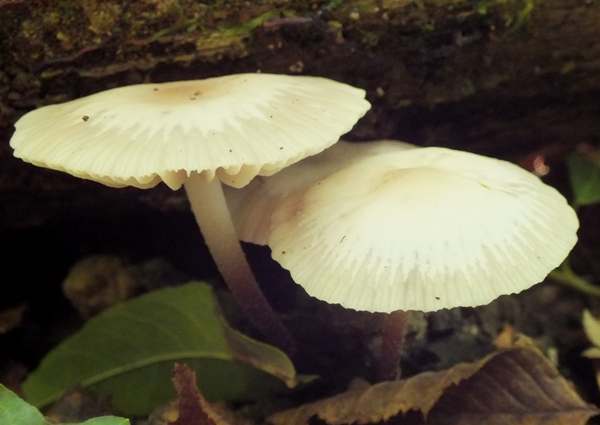
The two-tone stem of the Pearly Parchute is a helpful clue to its identity, but this little woodland mushroom needs more detailed study before you can be confident when separating it from the many other pale parachute species.
Distribution
In Britain and Ireland the Pearly Parachute is widespread and fairly common, as it is throughout most of mainland Europe from Scandinavia down to Spain, and also in parts of North America.
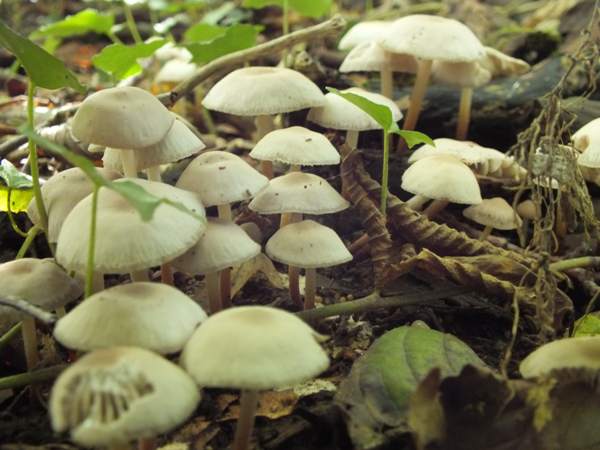
This and other members of the genus Marasmius are sometimes referred to as 'resurrection mushrooms' - they can dry out completely in hot sunny weather and yet, when eventually rain soaks them, they reflate and regain their characteristic shape and colour. Not only do the reconstituted mushrooms look like fresh young fruitbodies but they are also able to create new cells and to produce new spores. These Lazarus-like characteristics are the result of Marasmius fungi containing a high concentration of the sugar trehalose, which prevents catastrophic cell damage when the fruitbodies become desiccated.
Taxonomic history
This saprobic fungus was first described validly in scientific literature in 1859 by the English mycologists Miles Berkley and Christopher Broome, who gave it the scientific name Marasmius wynnei, since amended to Marasmius wynneae.
Synonyms of Marasmius wynneae include Agaricus globularis Weinm., Marasmius globularis (Weinm.) Fr., Collybia globularis (Weinm.) P. Karst., Marasmius archyropus var. suaveolens Rea, and Marasmius carpathicus Kalchbr.
Etymology
The genus name Marasmius comes from the Greek word marasmos, meaning 'drying out'. Elias Magnus Fries, who separated the Marasmius genus from the similar white-spored Collybia fungi, used as a key differentiating factor the ability of Marasmius mushrooms to recover if rehydrated after drying out. Fries called this characteristic 'marescence'.
The original collection by Berkeley and Broome for the description of this mushroom was made at the Coed Coch estate, near Dolwen in Denbighshire, North Wales UK, and the specific epithet is in honour of Mrs. Wynne (or Mrs. Lloyd Wynne?) who owned the estate with her husband and doubtless had an interest in mycology. I am grateful to Richard Daniel for kindly bringing this etymological information to my attention.
Identification guide
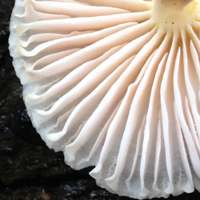 |
Cap2 to 5cm across; initially hemispherical then convex, flattening with a broad umbo; hygrophanous, greyish, drying to cream buff; margin appears striate when wet. |
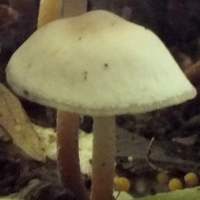 |
GillsAdnexed or free; distant; white at first, becoming cream sometimes tinged violet. |
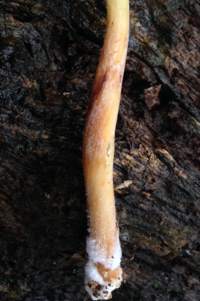 |
StemCylindrical, 3 - 10cm long and 2 - 5mm diameter; buff near the apex, progressively browner towards a white-powdered base. The stem flesh is whitish at the apex and browner and sometimes black towards the base. |
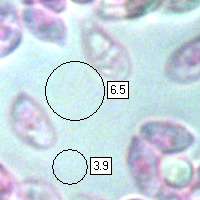 |
SporesEllipsoidal to pip-shaped, smooth, 5-7 x 3-3.5μm; inamyloid.
Spore printWhite. |
Odour/taste |
Not distinctive. |
Habitat & Ecological role |
Saprobic, on soil and leaf litter in deciduous woodland and on woodland edges, most commonly under beeches (Fagus spp.) but also quite often with oaks (Quercus) and Hazel (Corylus). |
Season |
Mainly seen from August to November in Britain and Ireland. |
Similar species |
Marasmius oreades, a common grassland mushroom, has a tan or buff cap and a stem concolorous with the cap |
Culinary notes
This insubstantial little mushroom is not generally considered edible.
Reference Sources
Fascinated by Fungi, 2nd Edition, Pat O'Reilly 2016, reprinted by Coch-y-bonddu Books in 2022.
Berkeley & Broom in Prideaux John Selby et al, The Annals and Magazine of Natural History Vol III - Third Series p358; Taylor & Francis, London.(1859)
Dictionary of the Fungi; Paul M. Kirk, Paul F. Cannon, David W. Minter and J. A. Stalpers; CABI, 2008
Taxonomic history and synonym information on these pages is drawn from many sources but in particular from the British Mycological Society's GB Checklist of Fungi.
Acknowledgements
This page includes pictures kindly contributed by Simon Harding.
Fascinated by Fungi. Back by popular demand, Pat O'Reilly's best-selling 450-page hardback book is available now. The latest second edition was republished with a sparkling new cover design in September 2022 by Coch-y-Bonddu Books. Full details and copies are available from the publisher's online bookshop...

